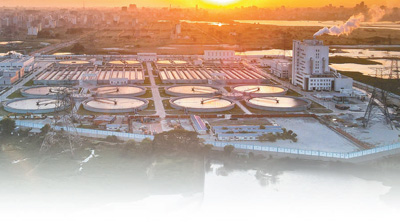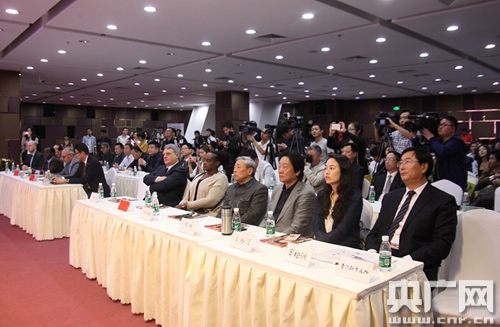Theoretical Hot Topics丨Lin Boqiang: Better Promote The Rapid Development Of Green Investment In The "Belt And Road"
Theoretical Hot Topics丨Lin Boqiang: Better Promote The Rapid Development Of Green Investment In The "Belt And Road"
Image source/Xinhua News Agency Core View China's green investment in countries jointly building the "Belt and Road" will inevitably bring about massive projects to land, thereby providing a richer development scenario for China's green investment to the international stage, and at the same time, it will also contribute to the global green and low-carbon transformation.
Core point
China's green investment in countries jointly building the "Belt and Road" will inevitably bring about massive projects to land, thus providing richer development scenarios for China's green investment to the international stage, and at the same time, it will also contribute to the global green and low-carbon transformation.
Lin Boqiang
In recent years, many countries jointly built the "Belt and Road" have submitted carbon emission reduction action plans to the United Nations and formulated ambitious energy transformation strategies, but these climate transformation actions require huge financial support. At present, the sovereign debt risks in many countries are rising, and the funding gap required for transformation continues to expand.
UN data shows that developing countries face an average of about $4 trillion in sustainable development financing gap per year. At the same time, developing countries urgently need to obtain more financing and grants to address the impact of climate change. Since 2009, global climate negotiations have set a goal of raising $100 billion a year to support developing countries in responding to climate change, but so far, the $100 billion target has not been achieved.
Therefore, China's green investment in countries jointly building the "Belt and Road" will inevitably lead to large-scale project implementation, thereby providing richer development scenarios for China's green investment to move to the international stage, and at the same time, it will also contribute to the global green and low-carbon transformation. In particular, against the backdrop of the current continued changes in the global trade pattern and the United States withdraws from the climate change agreement, it is becoming more important to promote China's rapid development of green investment in the "Belt and Road".
China has great potential for green investment in the Belt and Road Initiative
Countries jointly built the "Belt and Road" have natural resources such as hydraulics, wind, solar energy, etc. needed to develop clean energy. Driven by the dual promotion of the United Nations Climate Development Goals Initiative and the obstruction of traditional energy supply, many countries jointly built the "Belt and Road" actively develop clean energy such as hydraulics, wind, and solar energy. In the past 30 years, new energy consumption in countries jointly built the "Belt and Road" has increased by 868%, exceeding the global average growth rate. Argentina, Brazil, Serbia and other countries have set carbon neutrality goals.
In the future, in China's "Belt and Road" green energy investment, new energy projects such as wind power and photovoltaics will have a significant increase. China's photovoltaic technology innovation continues to make efforts, and the cost of photovoltaic has been further reduced, which has promoted the large-scale development of the photovoltaic industry. In addition to the field of renewable energy, the joint construction of the "Belt and Road" countries have also brought important development opportunities for Chinese companies in emerging industry markets such as hydrogen energy, energy storage, utility-grade energy storage batteries and new energy vehicles. In these emerging fields, leading Chinese companies will rely on their strong manufacturing strength, competitive cost and technological advantages to actively expand overseas production capacity, and thus promote the further expansion of China's green investment scale under the framework of the "Belt and Road".
China's green investment can alleviate the financing constraints of countries jointly building the "Belt and Road" initiative. On the one hand, compared with traditional technological innovation, green technological innovation faces greater financing constraints, and green investment in the "Belt and Road" can alleviate the financial pressure of enterprises. On the other hand, for enterprises participating in the construction of the "Belt and Road", the support for corporate projects by green investment in the "Belt and Road" can effectively alleviate corporate financing constraints.
First of all, financial institutions such as the Asian Infrastructure Investment Bank and the Silk Road Fund initiated and founded by China and relevant member states of the "Belt and Road" have provided massive green investments for the "Belt and Road" related cooperation projects.
Secondly, some countries jointly built the "Belt and Road" have given preferential policies to enterprises that China participated in the construction, alleviating certain financial pressure for Chinese companies' green investment.
Finally, while receiving national policies, enterprises participating in the "Belt and Road" green investment project have prompted financial lending institutions such as banking and other financial lending institutions to improve their trust in enterprises, and further alleviate the financing constraints of green investment in related enterprises through measures such as expanding the scale of loans.
The challenges to green investment in the Belt and Road Initiative remain
First, green standards are not unified. China's green investment path in the "Belt and Road" has been blocked, which is not conducive to providing a market for development. At present, China and the EU are two important markets in the global green finance field. In the context of economic globalization, the same project may face differentiated recognition standards in different countries and regions, which has brought certain troubles to the cross-border investment activities of some investment entities. For countries jointly building the "Belt and Road" policy, the "Catalogue of Common Classification of Sustainable Finance" jointly released by economies such as China and Europe is of great reference significance. This catalog can not only provide operational guidance for financial institutions to carry out green financial business, but also provide useful reference for the continuous promotion of multilateral green standards cooperation, and create reference financial templates for climate cooperation among countries. However, there are still many restrictions on the application of the "Catalogue of Common Classification of Sustainable Finance" in actual investment and cannot fully adapt to China's external green investment projects. In addition to the global green standards that have not yet formulated internationally common rules, China's internal green finance also lacks a complete guidance system. For example, Chinese companies have not yet established a unified environmental pollution disclosure system, green project recognition standards are not unified, and data between financial institutions are not interoperable.
Second, some countries jointly built the "Belt and Road" have insufficient concepts for sustainable development and have a poor foundation for economic development. Most of the countries that jointly build the "Belt and Road" have relatively backward economic development. The pillar industries are mainly primary industries and resource-intensive secondary industries with serious pollution. Due to the backward technology and development concepts, the green transformation of the economy faces great difficulties. In addition to weak economic development, some countries also face power shortages. According to the International Energy Agency, more than half of the population in some African countries are still in power shortage.
Third, political instability in countries jointly building the "Belt and Road" may bring risks to green investment. Green investment in the "Belt and Road" requires countries along the route to have a relatively stable political situation to meet the preparation and construction of the project. However, some countries that jointly build the "Belt and Road" often suffer from religious or political turmoil, and China's green investment may face uncertain policy factors, and projects are therefore at risk of default. Even in countries with relatively stable political situations, there is also a situation where the new government leaders do not recognize the previous government investment projects, resulting in a lack of coherence in project construction.
Fourth, the "Belt and Road" involves a wide regional scope, and the national conditions and development needs of countries along the route are different. Different countries have a big gap in multiple dimensions such as economic development level, cultural development and productivity development. Problems such as difficulty in coordinated development among countries, inconsistent export standards, and large differences in demand have increased the difficulty of green investment in China abroad.
Fifth, the instability of the "Belt and Road" investment projects restricts green investment from playing a role in the construction of the "Belt and Road". In recent years, international geopolitical conflicts have occurred frequently. The Russian-Ukrainian conflict and regional conflicts in the Middle East have caused countries to jointly build the "Belt and Road" to not only face huge pressure on economic development, but also face the risks of war in international politics. These factors have led to many countries jointly building the "Belt and Road" lacking the willingness and international environment to fully develop their economy, which has thus increased the difficulty of promoting China's new quality productivity to countries jointly building the "Belt and Road". In addition to the limited development of countries that jointly build the "Belt and Road" in cooperation, China's scientific and technological development also faces severe international environmental challenges. The camp of Western developed countries led by the United States has restricted China's development and international influence in the field of high-tech through trade wars and scientific and technological wars, which to a certain extent has also increased the difficulty of China's green investment in the "Belt and Road" investment projects.
Policy recommendations
First, participate in the formulation of international green standards, improve the support for the green investment system of the "Belt and Road", improve the level of project investment risk assessment, and provide institutional guarantees for green investment. First of all, global unified green standards have not been established internationally. As the world's largest green market, China and the EU have great advantages in the construction of green standards and systems. Therefore, China should actively participate in the formulation of globally common green standards. In the context of global green transformation and development, we will grasp China's voice in the international community in the construction of institutional systems and standard formulation. In the establishment of international standards, we must improve China's internal standards and platform construction as soon as possible, establish a complete corporate environmental information disclosure system, assessment system, and a unified information data platform, etc., to prepare for the docking of China's green standards with the international community's green standards. Secondly, China's "Belt and Road" green investment should improve the risk assessment mechanism and investment process for cross-border investment to reduce the political and environmental risks of "Belt and Road" green investment. Finally, China should encourage funds from society and other countries to join the green investment of the "Belt and Road", give full play to the institutional advantages of multilateral cooperation, expand the scale of green investment in the "Belt and Road", and establish and improve a green financial support system.
Second, optimize the project and location decisions for green investment in the "Belt and Road" and reduce the risk of green investment production. Since most countries jointly built the "Belt and Road" are developing countries, their economic foundation is relatively weak, and the awareness of green development has not yet been fully formed. Therefore, the location setting of projects for green investment in the "Belt and Road" needs to consider both the project economy and the host country's location advantages, and promote the common green development of the "Belt and Road" countries at the lowest cost. In addition to considering natural resources, the political and social environmental risks of the host country should also be evaluated to avoid unsustainable projects due to political issues and uncontrollable project costs caused by social environmental risks.
Third, Chinese enterprises should increase investment in innovation and accelerate the cultivation of green new quality productivity. First, enhance the awareness of innovation, cultivate an internal innovation-friendly atmosphere of enterprise, and encourage employees to develop awareness of high-end and high-tech green technology research and development. The second is to adopt production processes and production processes that meet the requirements of new quality productivity to improve product competitive advantages. The third is to introduce advanced international management models and talents to improve the total factor productivity of enterprises.
Fourth, promote the construction of the "Belt and Road" science and technology demonstration zone. Give full play to the role of China's green investment in the "Belt and Road" to drive the output of new quality productivity. Explore the construction of closer scientific and technological development partnerships and scientific and technological output channels in key areas such as new energy, new materials, high-end equipment, and new energy vehicles, establish overseas technology promotion demonstration zones, explore overseas green technology output channels and markets, and provide a market foundation for promoting the rapid development of China's "Belt and Road" green investment.
(The author is a chair professor at the School of Management of Xiamen University and dean of the China Energy Policy Research Institute)

Director-General Producer丨Wang Liejunche Haigang
Producer丨Chen Bo, Wang Yu, Yang Yuyang
Editor-in-chief丨Mao JinghuiEditor丨Jiang Shuai






